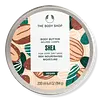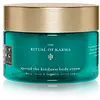What's inside
What's inside
 Key Ingredients
Key Ingredients

 Benefits
Benefits

 Concerns
Concerns

 Ingredients Side-by-side
Ingredients Side-by-side

Water
Skin ConditioningButyrospermum Parkii Butter
Skin ConditioningCetearyl Alcohol
EmollientTheobroma Cacao Seed Butter
EmollientGlycerin
HumectantCetearyl Glucoside
EmulsifyingTriethyl Citrate
MaskingOrbignya Oleifera Seed Oil
EmollientDimethicone
EmollientOryza Sativa Bran Wax
Skin ConditioningPhenoxyethanol
PreservativeSodium Stearoyl Glutamate
CleansingParfum
MaskingCaprylyl Glycol
EmollientXanthan Gum
EmulsifyingTocopherol
AntioxidantCitric Acid
BufferingLinalool
PerfumingCoumarin
PerfumingAlpha-Isomethyl Ionone
PerfumingLimonene
PerfumingCaramel
Cosmetic ColorantCI 19140
Cosmetic ColorantWater, Butyrospermum Parkii Butter, Cetearyl Alcohol, Theobroma Cacao Seed Butter, Glycerin, Cetearyl Glucoside, Triethyl Citrate, Orbignya Oleifera Seed Oil, Dimethicone, Oryza Sativa Bran Wax, Phenoxyethanol, Sodium Stearoyl Glutamate, Parfum, Caprylyl Glycol, Xanthan Gum, Tocopherol, Citric Acid, Linalool, Coumarin, Alpha-Isomethyl Ionone, Limonene, Caramel, CI 19140
Water
Skin ConditioningCetearyl Alcohol
EmollientGlycerin
HumectantCaprylic/Capric Triglyceride
MaskingPropylheptyl Caprylate
EmollientUndecane
EmollientHelianthus Annuus Seed Oil
EmollientParfum
MaskingCamellia Sinensis Leaf Extract
AntimicrobialNelumbo Nucifera Flower Extract
Skin ConditioningCentella Asiatica Leaf Extract
Skin ConditioningTocopherol
AntioxidantTocopheryl Acetate
AntioxidantUbiquinone
AntioxidantPropylene Glycol
HumectantAllantoin
Skin ConditioningCaprylyl Glycol
EmollientCarbomer
Emulsion StabilisingSodium Polyacrylate
AbsorbentGlyceryl Stearate
EmollientCeteareth-20
CleansingCeteareth-12
EmulsifyingCetyl Palmitate
EmollientTridecane
PerfumingIsohexadecane
EmollientButylene Glycol
HumectantBenzyl Salicylate
PerfumingCitral
PerfumingCitronellol
PerfumingHexyl Cinnamal
PerfumingLinalool
PerfumingAlpha-Isomethyl Ionone
PerfumingLimonene
PerfumingPhenoxyethanol
PreservativePotassium Sorbate
PreservativeSorbic Acid
PreservativeSodium Hydroxide
BufferingWater, Cetearyl Alcohol, Glycerin, Caprylic/Capric Triglyceride, Propylheptyl Caprylate, Undecane, Helianthus Annuus Seed Oil, Parfum, Camellia Sinensis Leaf Extract, Nelumbo Nucifera Flower Extract, Centella Asiatica Leaf Extract, Tocopherol, Tocopheryl Acetate, Ubiquinone, Propylene Glycol, Allantoin, Caprylyl Glycol, Carbomer, Sodium Polyacrylate, Glyceryl Stearate, Ceteareth-20, Ceteareth-12, Cetyl Palmitate, Tridecane, Isohexadecane, Butylene Glycol, Benzyl Salicylate, Citral, Citronellol, Hexyl Cinnamal, Linalool, Alpha-Isomethyl Ionone, Limonene, Phenoxyethanol, Potassium Sorbate, Sorbic Acid, Sodium Hydroxide
 Reviews
Reviews

Ingredients Explained
These ingredients are found in both products.
Ingredients higher up in an ingredient list are typically present in a larger amount.
Alpha-Isomethyl Ionone is a fragrance. It can be synthetically created or naturally occurring.
The scent of Alpha-Isomethyl Ionone is described as "flowery" but can also be "woody".
Naturally occurring Alpha-Isomethyl Ionone may be found in Saccharomyces cerevisiae, or the yeast used to make wine and bread.
The term 'fragrance' is not regulated in many countries. In many cases, it is up to the brand to define this term. For instance, many brands choose to label themselves as "fragrance-free" because they are not using synthetic fragrances. However, their products may still contain ingredients such as essential oils that are considered a fragrance.
Learn more about Alpha-Isomethyl IononeCaprylyl Glycol is a humectant and emollient, meaning it attracts and preserves moisture.
It is a common ingredient in many products, especially those designed to hydrate skin. The primary benefits are retaining moisture, skin softening, and promoting a healthy skin barrier.
Though Caprylyl Glycol is an alcohol derived from fatty acids, it is not the kind that can dry out skin.
This ingredient is also used as a preservative to extend the life of products. It has slight antimicrobial properties.
Learn more about Caprylyl GlycolCetearyl alcohol is a mixture of two fatty alcohols: cetyl alcohol and stearyl alcohol. It is mainly used as an emulsifier. Emulsifiers help prevent the separation of oils and products. Due to its composition, it can also be used to thicken a product or help create foam.
Cetearyl alcohol is an emollient. Emollients help soothe and hydrate the skin by trapping moisture.
Studies show Cetearyl alcohol is non-toxic and non-irritating. The FDA allows products labeled "alcohol-free" to have fatty alcohols.
This ingredient is usually derived from plant oils such as palm, vegetable, or coconut oils. There is debate on whether this ingredient will cause acne.
Due to the fatty acid base, this ingredient may not be Malassezia folliculitis safe.
Learn more about Cetearyl AlcoholGlycerin is already naturally found in your skin. It helps moisturize and protect your skin.
A study from 2016 found glycerin to be more effective as a humectant than AHAs and hyaluronic acid.
As a humectant, it helps the skin stay hydrated by pulling moisture to your skin. The low molecular weight of glycerin allows it to pull moisture into the deeper layers of your skin.
Hydrated skin improves your skin barrier; Your skin barrier helps protect against irritants and bacteria.
Glycerin has also been found to have antimicrobial and antiviral properties. Due to these properties, glycerin is often used in wound and burn treatments.
In cosmetics, glycerin is usually derived from plants such as soybean or palm. However, it can also be sourced from animals, such as tallow or animal fat.
This ingredient is organic, colorless, odorless, and non-toxic.
Glycerin is the name for this ingredient in American English. British English uses Glycerol/Glycerine.
Learn more about GlycerinLimonene is a fragrance that adds scent and taste to a formulation.
It's found in the peel oil of citrus fruits and other plants such as lavender and eucalyptus. The scent of limonene is generally described as "sweet citrus".
Limonene acts as an antioxidant, meaning it helps neutralize free radicals.
When exposed to air, oxidized limonene may sensitize the skin. Because of this, limonene is often avoided by people with sensitive skin.
The term 'fragrance' is not regulated in many countries. In many cases, it is up to the brand to define this term. For instance, many brands choose to label themselves as "fragrance-free" because they are not using synthetic fragrances. However, their products may still contain ingredients such as essential oils that are considered a fragrance.
Learn more about LimoneneLinalool is a fragrance and helps add scent to products. It's derived from common plants such as cinnamon, mint, citrus, and lavender.
Like Limonene, this ingredient oxidizes when exposed to air. Oxidized linalool can cause allergies and skin sensitivity.
This ingredient has a scent that is floral, spicy tropical, and citrus-like.
Learn more about LinaloolParfum is a catch-all term for an ingredient or more that is used to give a scent to products.
Also called "fragrance", this ingredient can be a blend of hundreds of chemicals or plant oils. This means every product with "fragrance" or "parfum" in the ingredients list is a different mixture.
For instance, Habanolide is a proprietary trade name for a specific aroma chemical. When used as a fragrance ingredient in cosmetics, most aroma chemicals fall under the broad labeling category of “FRAGRANCE” or “PARFUM” according to EU and US regulations.
The term 'parfum' or 'fragrance' is not regulated in many countries. In many cases, it is up to the brand to define this term.
For instance, many brands choose to label themselves as "fragrance-free" because they are not using synthetic fragrances. However, their products may still contain ingredients such as essential oils that are considered a fragrance by INCI standards.
One example is Calendula flower extract. Calendula is an essential oil that still imparts a scent or 'fragrance'.
Depending on the blend, the ingredients in the mixture can cause allergies and sensitivities on the skin. Some ingredients that are known EU allergens include linalool and citronellol.
Parfum can also be used to mask or cover an unpleasant scent.
The bottom line is: not all fragrances/parfum/ingredients are created equally. If you are worried about fragrances, we recommend taking a closer look at an ingredient. And of course, we always recommend speaking with a professional.
Learn more about ParfumPhenoxyethanol is a preservative that has germicide, antimicrobial, and aromatic properties. Studies show that phenoxyethanol can prevent microbial growth. By itself, it has a scent that is similar to that of a rose.
It's often used in formulations along with Caprylyl Glycol to preserve the shelf life of products.
Tocopherol (also known as Vitamin E) is a common antioxidant used to help protect the skin from free-radicals and strengthen the skin barrier. It's also fat soluble - this means our skin is great at absorbing it.
Vitamin E also helps keep your natural skin lipids healthy. Your lipid skin barrier naturally consists of lipids, ceramides, and fatty acids. Vitamin E offers extra protection for your skin’s lipid barrier, keeping your skin healthy and nourished.
Another benefit is a bit of UV protection. Vitamin E helps reduce the damage caused by UVB rays. (It should not replace your sunscreen). Combining it with Vitamin C can decrease sunburned cells and hyperpigmentation after UV exposure.
You might have noticed Vitamin E + C often paired together. This is because it is great at stabilizing Vitamin C. Using the two together helps increase the effectiveness of both ingredients.
There are often claims that Vitamin E can reduce/prevent scarring, but these claims haven't been confirmed by scientific research.
Learn more about TocopherolWater. It's the most common cosmetic ingredient of all. You'll usually see it at the top of ingredient lists, meaning that it makes up the largest part of the product.
So why is it so popular? Water most often acts as a solvent - this means that it helps dissolve other ingredients into the formulation.
You'll also recognize water as that liquid we all need to stay alive. If you see this, drink a glass of water. Stay hydrated!
Learn more about Water